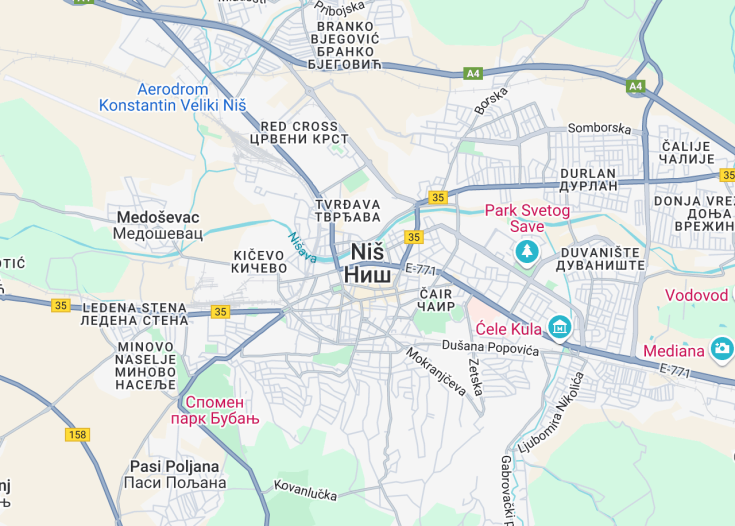Niš, the third-largest city in Serbia, nestled at the crossroads of Balkan and European highways, presents a blend of ancient history, vibrant culture, and scenic beauty. This historic city, famed as the birthplace of Constantine the Great, offers an array of well-preserved monuments, from Roman ruins and Ottoman fortresses to contemporary museums. Niš echoes the tales of its past through its intriguing architecture and the lively ambience of its streets and markets. A haven for history enthusiasts and cultural explorers, Niš serves as a captivating gateway to the rich heritage of Serbia.
Ensure to experience the ancient Niš Fortress and the unique Mediana archaeological site for a glimpse into the city’s profound historical layers.
Visit Niš in late summer to enjoy the Nišville Jazz Festival, an internationally acclaimed event that showcases a perfect fusion of music and cultural diversity.
Niš: A Gateway to Serbian History
| Country | Serbia |
| Time in Niš | GMT+2 |
| Language spoken | Serbian |
| Population | 260,000 (Latest Serb census data) |
| Currency | Serbian Dinar (RSD) |
| Airports | Niš Constantine the Great Airport (2.5 mi / 4 km). |
Niš, one of Serbia’s major cities, holds a significant place in the cultural and historical landscape of the region. Known as the birthplace of Constantine the Great, the city’s rich history is evident in its well-preserved monuments and historical sites, including the Niš Fortress and the Skull Tower. The city also serves as a hub for cultural events, such as the Nišville Jazz Festival, which attracts international artists and tourists.
Where is Niš?
Located in the southeastern part of Serbia, near the confluence of the Nišava and Morava rivers.
Distances:
[Create a table with the following columns: “Route”, “Distance by car”, “Time by car”. List the most popular routes from major cities in Serbiato Niš, and fill in the respective data without approximations.]
What is Nišfamous for?
Niš is famous for its historical sites, particularly the Niš Fortress and the Skull Tower, vivid reminders of the city’s past and resilience.
History
Prehistoric to Roman Era
Archaeological findings indicate that the Niš area has been inhabited since prehistoric times, showcasing remnants from the Neolithic era. The Celts established a settlement here in the 3rd century BC, which was later conquered by the Romans in the 1st century BC. This location’s strategic importance was recognized by Roman Emperor Constantine the Great, who was born here around AD 280, making Niš a significant Roman city known as Naissus.
Byzantine and Medieval Period
With the division of the Roman Empire, Niš became a border city of the Byzantine Empire. Throughout the medieval period, it faced numerous invasions from various forces, including the Slavs, Bulgarians, and Ottomans, all drawn by its strategic location at the crossroads of European trade routes. The city was an important military and administrative center, often changing rulers due to its geopolitical significance.
Ottoman Rule (1386–1878)
Niš fell under Ottoman rule in the late 14th century. The Ottomans built numerous architectural works, including fortresses, mosques, and baths, many of which define the city’s landscape even today. Niš also served as a gruesome reminder of Ottoman power; the Škull Tower, built from the skulls of Serbian rebels, was constructed here after the Serbian defeat at the Battle of Čegar in 1809.
Modern Era (1878–Present)
The liberation of Niš from the Ottomans in 1878 opened a new chapter in its history. The city rapidly modernized, embracing industrialization and later playing a significant role in both the Balkan Wars and World Wars. In WWII, Niš was a center of resistance against German occupation. Today, it is known for its rich historical legacy, cultural significance, and as a vibrant university center, continuing to be an essential part of Serbia’s cultural and economic fabric.
Visit Niš
What to see and do in Niš
Niš, a city steeped in history, offers a plethora of attractions and activities for visitors. Key sites include the Niš Fortress, a well-preserved example of Ottoman architecture; the archaeologically significant Mediana, a luxurious residence from Roman times; and the chilling Škull Tower. For cultural experiences, the National Theatre and the Niš Symphony Orchestra offer regular performances. Visitors can also explore the vibrant café culture and the bustling markets of Niš.
- Niš Fortress
- Mediana
- Škull Tower
- Niš National Theatre
- Local cafés and markets
Festivities in Niš
Niš hosts various annual events that reflect its rich cultural tapestry. The Nišville Jazz Festival in August transforms the city into a jazz hub, drawing international artists and fans. The Film Festival, held each September, showcases local and international films. These events, among others, provide a vibrant atmosphere and a deep dive into the cultural life of the city.
Best time to visit Niš
The best time to visit Niš is between late spring and early autumn, especially from May through September. During this period, the weather is most favorable for exploring the outdoor historical sites, and the city’s cultural calendar is brimming with festivals and events.
Is Niš worth visiting?
Niš is decidedly worth a visit for those intrigued by rich history meshed with vibrant cultural scenes. The city not only offers a deep dive into Serbia’s tumultuous history but also presents a lively contemporary cultural and social scene, making it an enriching experience for any traveler.









